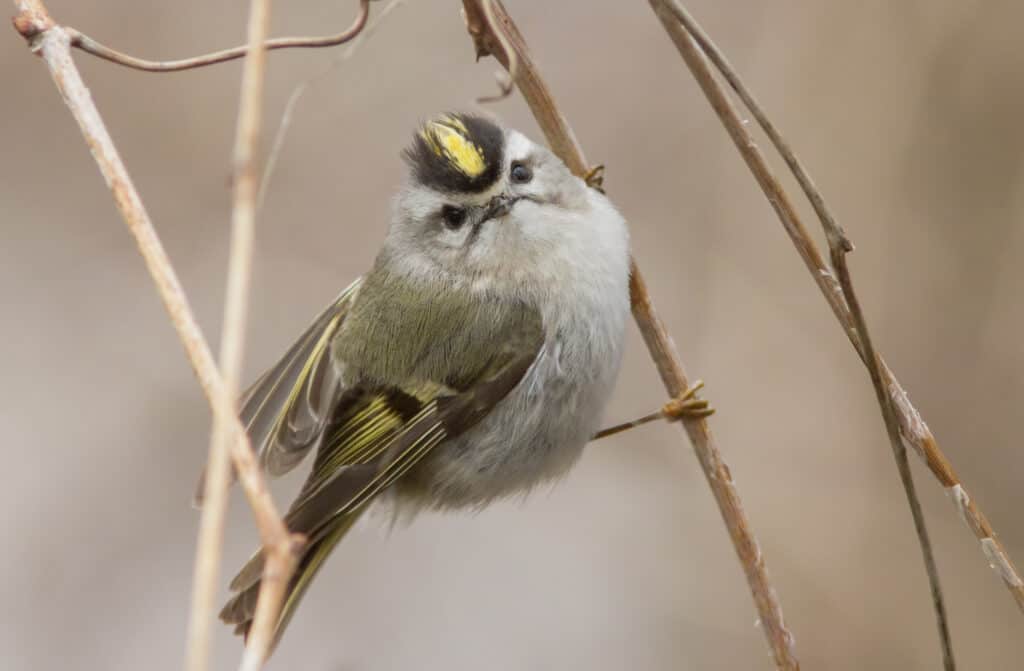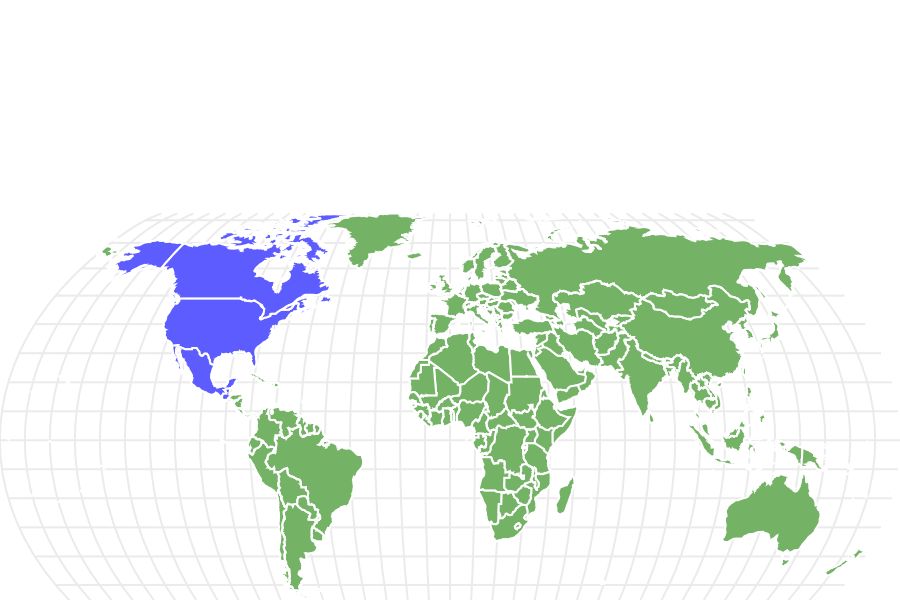Golden-Crowned Kinglet
Regulus Satrapa
They huddle together for warmth
Advertisement
Golden-Crowned Kinglet Scientific Classification
- Kingdom
- Animalia
- Phylum
- Chordata
- Class
- Aves
- Order
- Passeriformes
- Family
- Regulidae
- Genus
- Regulus
- Scientific Name
- Regulus Satrapa
Read our Complete Guide to Classification of Animals.
Golden-Crowned Kinglet Conservation Status
Golden-Crowned Kinglet Facts
- Prey
- Insects
- Name Of Young
- Chicks
- Group Behavior
- Social
- Pair
- Fun Fact
- They huddle together for warmth
- Estimated Population Size
- 140 million
- Biggest Threat
- Habitat loss
- Most Distinctive Feature
- yellow and orange crown feathers
- Wingspan
- 5.5 to 7.1 inches
- Incubation Period
- 15 days
- Age Of Fledgling
- 14 to 19 days
- Habitat
- Dense coniferous forests
- Diet for this Fish
- Insectivore
- Lifestyle
- Diurnal
- Favorite Food
- arthropods, insect eggs
- Type
- Bird
- Common Name
- Golden-crowned kinglet
- Number Of Species
- 5
- Location
- Canada, United States, Mexico
- Nesting Location
- Tops if conifer trees
- Age of Molting
- 6 months
- Migratory
- 1
View all of the Golden-Crowned Kinglet images!
They huddle together for warmth.
The golden-crowned kinglet has a distinctive, flashy yellow crown and black eyebrow stripes, making them easy to differentiate. However, they prefer to stay on the tops of high trees; it requires patience to get a good look. These birds are tiny, but they can remarkably survive in cold climates by taking shelter in dense conifers and huddling together for warmth. Find out all the amazing facts about these unique birds!
5 Amazing Golden-Crowned Kinglet Facts
- Despite their minuscule size, golden-crowned kinglets can survive in -40 degree temperatures overnight.
- Their diet includes insect and spider eggs.
- Males defend their nesting territory by singing.
- They raise two large broods of young at the same time.
- Phishing sounds (small, rapid sounds) attract kinglets.
Where to Find the Golden-Crowned Kinglet
Golden-crowned kinglets breed mainly in dense coniferous forests (from 6 to 60 feet high), especially fir, spruce, and hemlock. They may also nest in deciduous and mixed forests, hemlocks, wooded bogs, and park groves. This bird stops in many habitats when they migrate, such as coniferous forests, fields, parks, and backyards. They will still seek out coniferous and deciduous forests when they reach their wintering environments but may also include swamps, riversides, cities, and suburbs.
To find this kinglet species, keep your eyes on the tops of the dense strands of spruce and fir trees, particularly during the summer. In winter, you can typically find them in shrubs or deciduous trees. If you can’t see them, listen for the high, thin calls they make while foraging. Then, look for quick movements high in the trees. Try making phishing noises to attract them. But don’t be surprised if you attract other birds, too!
You can find them in a number of North American and Central American countries, including Guatemala, Mexico, Canada, and the United States.
Golden-Crowned Kinglet Nest
Males and females work together for about four to five days constructing their nest. It will be no higher than 60 feet above the ground on the tops of conifer trees near the trunk. They attach it to hanging twigs with plenty of overhanging needles to protect it. The female constructs the inner cup with soft material like leaves, moss, spiderwebs, and feathers. The outer nest features similar material but with the addition of insect cocoons and strips of bark. The completed nest is three inches high and three inches across, with an inner cup 1.5 inches tall and the same across.
Scientific Name
This bird’s scientific name is Regulus satrapa. Its family name Regulidae is its only genus and derives from the Latin word regulus, meaning “a king.” It refers to the kinglet’s yellow or orange crests atop its head. The golden-crowned kinglet has three migratory subspecies: apache, olivaceus, and satrapa. You will find them throughout the United States and Canada; they differ in size, bill length, and rump color. There are two other nonmigratory species: aztecus and clarus, both of which inhabit the mountains of Mexico.
Size, Appearance, and Behavior
These tiny songbirds weigh between 0.1 and 0.3 ounces, smaller than a chickadee but more than a hummingbird. They have round bodies, short wings, short bills, and skinny tails. On average, their length is between 3.1 and 4.3 inches, with a wingspan of 5.5 to 7.1 inches. Their coloring is pale green and gray with black and white faces and a bright yellow and orange crown. They also have white wingbars and black flight feathers with yellow edges.
Golden-crowned kinglets form monogamous pair bonds and raise two broods every season, sometimes overlapping each other. Males are territorial and stand guard near their nest, often making fast noises and raising their crown feathers. While these birds are solitary during breeding, they become more social during migration and wintering. You will often find them in flocks with other small songbirds.

Golden-crowned kinglets have black and white faces and a bright yellow and orange crown
©Mircea Costina/Shutterstock.com
Migration Pattern and Timing
The golden-crowned kinglet is a resident and medium-distance migrant. Those that inhabit the Appalachians and Western mountains tend to stay year-round, but those that breed in Canada will migrate south to spend their winters across much of the United States. There are also species of golden-crowned kinglets that stay year-round in the mountains of Mexico.
Diet
Golden-crowned kinglets primarily eat small insects but will feed on seeds during winter.
What Does the Golden-Crowned Kinglet Eat?
Their diet consists mainly of tiny insects, like beetles, caterpillars, gnats, crickets, lice, grasshoppers, aphids, and many others. During the breeding season, they prefer to forage for arthropods and their eggs underneath the bark. In winter, they occasionally eat a small number of seeds and forage in the brush. They may even eat oozing sap but will rarely eat fruit.
Predators, Threats, and Conservation Status
The IUCN lists the golden-crowned kinglet’s status as “least concern.” This species has an extensive range with stable population numbers. Therefore, they do not meet the criterion for a “threatened” animal. In some areas, like Puget Sound, their numbers have decreased. Officials are not entirely sure why, but they believe the loss of forest habitats and climate change could affect their population. Overall, the population decrease is not concerning yet.
What Eats the Golden-Crowned Kinglet?
Due to its tiny size, this kinglet faces many predators, especially during the breeding season. These nest predators include squirrels and blue jays. The adults can also face threats from hawks, owls, and bobcats.
Reproduction, Young, and Molting
After the pair constructs their nest, females lay between five and 11 eggs, an average of around eight or nine. They often arrange their surprising amount of eggs into two layers; then, the female incubates by herself for 14 to 15 days. The young leave the nest 14 to 19 days after hatching, and the female only feeds them one day after they fledge before she begins incubating her second brood. The male will take over feeding the first brood and occasionally brings the incubating female food—their young molt into their adult plumage by the first fall.
Population
According to IUCN, 140 million mature individual golden-crowned kinglets are in the wild. From 1970 to 2017, their species underwent a moderate decline of 0.5% per year, but the population remains steady overall.
Up Next:
View all 170 animals that start with GGolden-Crowned Kinglet FAQs (Frequently Asked Questions)
How fast does the golden-crowned kinglet fly?
Their flight is fast and erratic, moving around 30 Mph.
How do you find the golden-crowned kinglet?
These birds are hard to spot because they live in dense needles high up in trees. Look for them in spruce and fir trees during the summer or in shrubs and deciduous trees in the winter.
What time of year is best for finding the golden-crowned kinglet?
The best time to see the golden-crowned kinglet depends on where you live. The best time to see them in the United States is during winter, and the best time for Canada viewing is in summer.
How big is the golden-crowned kinglet?
These birds are smaller than a chickadee but more prominent than a hummingbird. They measure between 3.1 and 4.3 inches.
What color is the golden-crowned kinglet?
These birds are olive and gray with black and white faces and yellow and orange crowns. Their feathers also have white wing bars and yellow edges.
When does the golden-crowned kinglet migrate?
The golden-crowned kinglet migrates earlier in spring and later in fall, typically around March-April and October-November.
What does the golden-crowned kinglet eat?
They eat mainly insects such as grasshoppers, crickets, live, and beetles. They may also eat a small number of seeds during winter.
What threatens the golden-crowned kinglet?
As of now, there are no serious threats facing the golden-crowned kinglet. However, there is a possibility of them facing habitat loss and pressures from climate change.
What is a golden-crowned kinglet baby called?
Their babies are called juveniles or chicks.
How long does the golden-crowned kinglet live?
How long does the golden-crowned kinglet live?
How does the golden-crowned kinglet mate?
It is unknown exactly how golden-crowned kinglets mate, but we do know that they form monogamous pairs.
Thank you for reading! Have some feedback for us? Contact the AZ Animals editorial team.
Sources
- IUCN Red List, Available here: https://www.iucnredlist.org/species/22712594/139443885
- Bio One, Available here: https://bioone.org/journals/the-wilson-bulletin/volume-115/issue-2/03-035/OVERNIGHTING-OF-GOLDEN-CROWNED-KINGLETS-DURING-WINTER/10.1676/03-035.short
- JSTOR, Available here: https://www.jstor.org/stable/4163582
- Oxford Academic, Ornithology, Available here: https://academic.oup.com/auk/article/108/4/880/5172640
- JSTOR, Available here: https://www.jstor.org/stable/3809117

















